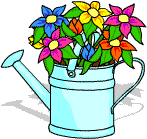The Cranky Gardener
Created | Updated Feb 19, 2004

A Penny Saved is a Penny Earned
There's something I should tell you about myself. Besides being cranky I'm also forgetful. This has resulted in not being able to find my lists of seeds that require special conditions to germinate. It's here somewhere. And when I find it, I'll share it with you as promised last time.
Ok, that's over with, let's talk lettuce.
One of the most satisfying ways for brand new gardeners to get their feet wet is to plant a salad garden. Most salad ingredients are easy to grow, give quick results, and taste wonderful compared to their store-bought counterparts. Another plus is that many salad crops tolerate (actually prefer) cool weather, so you can get started growing early in the spring.
My grandfather always planted his peas and his salad bed on Valentine's Day. I personally think this is a bit early and it is better to wait until the first of March. But he was a great gardener, so what do I know? He planted peas, lettuce, radishes, and green onions on Valentine's Day, potatoes and cabbage on St Patrick's Day, and annual flower seed on Good Friday. Corn was planted when the oak leaves were the size of a squirrel's ear.
Actually, I do know something about early planting. Whereas it is true that seed planted on Valentine's Day will germinate and grow, it is also true that it will do so more slowly than if you wait another two or three weeks. So, you aren't going to actually pick peas from a Valentine's Day sowing any sooner than you do from an early March sowing. Or lettuce. Or radishes. Or anything else. Not where I live.
Back to lettuce. Most people plant lettuce seed directly into the garden. But I know a couple who are fanatical about not wasting seed of any kind. They expect a plant from every seed and are extremely annoyed when this doesn't happen. So they start their lettuce inside and transplant the seedlings into the garden. Lettuce seed is large enough to handle easily and with a little patience you can sow it directly into the soil with little waste. But hey, if having tiny little lettuces growing on your windowsill makes you happy, go right ahead. Sowing indoors is also practical if you have very wet springs and your salad bed stays too wet to work.
Lettuce comes in many shapes, colors and sizes. If you are going to the trouble of growing your own, then it is fun to plant several varieties. Our modern lettuces are descendants from a wild species called Lactuca serriola, which is found in Asia, North Africa and Northern Europe. Lettuces are available in various shades of green, red tipped, speckled, swirled, blotched, reds, pinks, yellows and burgundy. There is absolutely no excuse for a salad to be boring.
I like to buy lettuce mixtures. Many seed companies have their own blends. My favourite is a mixture of Romaine, Salad Bowl, Red Salad Bowl, and Green Ice. The mixtures are more economical than buying packets of all four varieties. I also always plant an old family favourite called Black Seeded Simpson for my mother and a variety called Merlot which is a deep burgundy and is absolutely gorgeous. Another beautiful variety is Red Sails.
I plant spinach with my lettuce to provide a deep green in my salads. My favorite variety is Bloomsdale Long Standing. Both spinach and lettuce do best in a rich, moist soil with high nitrogen content. I plant lettuce and spinach every three weeks between March 1st and May 15th. This provides me with a continuous supply of spring and early summer salads. My summers are very hot and dry and lettuce doesn't do well for me during the summer. I envy those gardeners whose climates permit them to have healthy salad beds from spring through fall.
Other vegetables grown in my early spring salad garden are radishes, green onions planted from onion sets, carrots, Chinese cabbage, parsley and chives. When the soil warms I set out cherry tomatoes in space freed up by harvesting some of the lettuce, bell peppers, and cucumbers.
To get a jump on the season, you can plant a tomato, pepper and cucumber inside tomato cages them wrap the cages clear to the ground with plastic wrap from the kitchen. Cover the top of the cages and poke a few holes in the plastic wrap for ventilation. This will protect your seedlings and will let you harvest fresh vegetables three or four weeks sooner.
Lettuces and other salad vegetables will also grow well in large pots. I have three large dish garden pots that I like to fill with good potting soil and sow lettuces, spinach and green onions in. They can be moved into and out of the house if necessary. I have a neighbour who even grows early cucumbers in a large pot.
The important thing is to plant those vegetables that you like. Don't use someone else's list. This is the same, of course, for your main summer vegetable crops.
All this talk about salads has made me hungry. This week's recipe is for one of my favourite salad dressings. It is very easy to make and tastes wonderful.
Lemon Vinaigrette
Ingredients:
- 2 Tablespoons lemon juice
- 6 Tablespoons olive oil
- ½ teaspoon salt
- ½ teaspoon Dijon mustard
- Freshly ground pepper
- 1 teaspoon chopped fresh tarragon leaves (optional)
Combine all of the ingredients in a bowl and beat with a whisk until mixed thoroughly.
